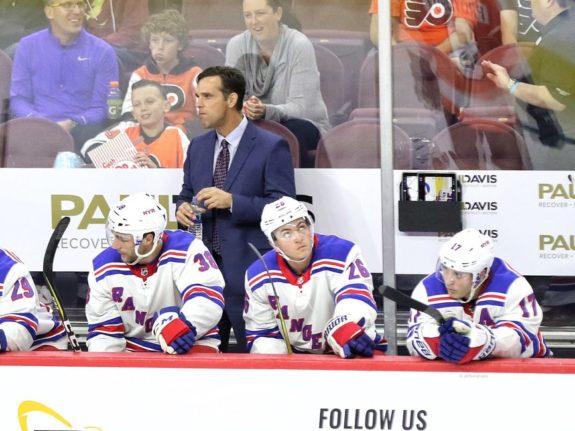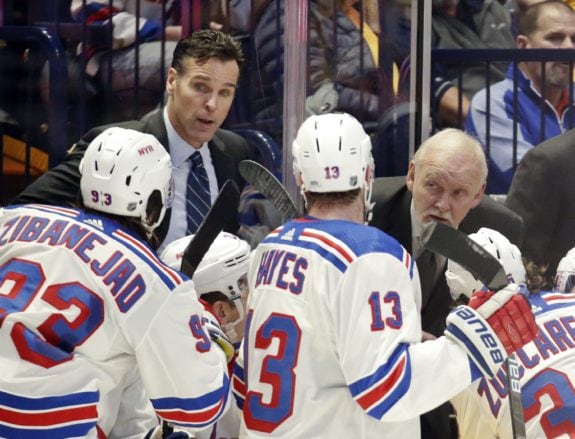New York Rangers head coach David Quinn will be entering his third season as an NHL head coach and it will be a big one for him. He was brought in to lead the young Rangers through their rebuild and teach them how to win. The choice made perfect sense as Quinn was coaching at Boston University, he was very familiar with coaching young players. Since the Rangers announced the start of their rebuild, the lineup has been full of young and inexperienced players. The hire looked fantastic and seemed to be a great fit on paper. Three years later, it would be safe to assume the grace period is over and that now is the time for results.
The Team’s Records
One of the biggest things people will point to in regards to a coach’s success is the team’s record. In his first full season as head coach, the Rangers went 32-36-14 and ended the season with 78 points, finishing second to last in the Metropolitan Division and 26th in the entire league. The Rangers were 20 points out of a playoff spot. The roster that season was rather depleted as a result of the rebuild — many of the team’s top players were either already traded or got traded that season.

This past season, the Rangers went 37-28-5 with 79 points and were limited to 70 games due to the season ending early. Once again they ended up second to last in the Metropolitan Division, but they were far more competitive in the stacked division, only two points out of a wildcard spot. They moved up to 16th in the league and squeaked into the playoffs due to the extended format. Had the season played out like normal, they would have been battling tooth and nail for a wildcard spot. That is a considerable improvement but the roster was also much better, largely due to superstar winger Artemi Panarin.
The Player Development Under Him
For a development coach, the results and improvements among his players are the most important thing. If players were making progress, he did his job. Some players saw improvements during Quinn’s tenure and some saw setbacks. In the cases of Mika Zibanejad, Pavel Buchnevich and Tony DeAngelo, the skills were all there for them to succeed, they just needed the opportunity. While they were given the opportunity, they did quickly rise in the depth chart due to the roster moves as a result of the rebuild.
Quinn deserves some credit in the case of DeAngelo, he was a hot-headed player with attitude problems. When those problems reared their ugly head, Quinn, a fiery personality himself, tried to nip it in the bud and sit the Jersey boy in the press box. In the end, it looks like Quinn found the right buttons to press to keep DeAngelo’s antics in check. (from ‘Tony DeAngelo needs no explanation for benching,’ New York Post, 03/12/2019)
Players like Ryan Strome and Ryan Lindgren have found their own levels of success under the former Boston coach. Strome has had a career revival since being traded to the Rangers as the number two center. (from ‘Ryan Strome’s value rising in Rangers line blender,’ New York Post, 12/10/2019) Sure, playing with Panarin helped this season but his first season with the Rangers saw him score 18 goals in 63 games, a total he tied in 70 this season.
Lindgren, on the other hand, was able to start his career. While he did get a five-game stint in the 2018-19 season, he carved out a permanent role on the blue line in the 2019-20 season. Although he started in the AHL, it was only for nine games before coming up to the NHL where he never looked back. While we may never know just how much work the two put in together, whatever Lindgren did paid off as he became a solid defensive defenseman and formed a great pairing with fellow rookie Adam Fox. Fox was just as good at the end of the season as he was from the day he came to Broadway. The two became the best pairing on the team by the season’s end.
There have also been quite a few instances where players have not worked out too well. The Rangers’ brass finally saw enough of Brady Skjei’s struggle to regain his impressive form as a rookie. Marc Staal continued to show deterioration in his play but was only a healthy scratch once. Libor Hajek looked lost after an impressive five-game debut the season before and Brett Howden regressed mightily from an impressive start to his career just one season before. Kaapo Kakko fell far behind the expectations set for him largely due to his deployment.

Then of course, the elephant in the room is the Lias Andersson situation, which finally came to an end during the 2020 Entry Draft. He did not work out as a Ranger after spending the season glued to the bottom line with defenseman Brendan Smith and enforcer Micheal Haley.
With more young talent on the way, the Rangers want to be sure they get the best development possible before they enter their window of contention. There were some questionable development moves like Filip Chytil excelling during the absence of Zibanejad but then never getting another look in the top six or Kakko only playing 141:57 time on ice with the team’s top winger despite them having a positive impact together, instead using a two-way player like Jesper Fast.
Quinn may have to use some new lineup deployments and tactics to show he can get the best out of his young players. If they do not show progress, his days as the Rangers’ bench boss could be numbered.